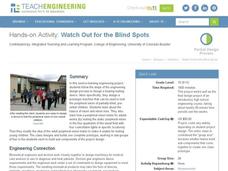Curated and Reviewed by
Lesson Planet
This Watch Out for the Blind Spots activity also includes:
- Pre/Post Quiz (.pdf)
- Pre/Post Quiz (.doc)
- Pre/Post Quiz Answers (.pdf)
- Pre/Post Quiz Answers (.doc)
- Presentation Peer Review Form (.pdf)
- Presentation Peer Review Form (.doc)
- Evaluation/Grading Rubric (.pdf)
- Evaluation/Grading Rubric (.doc)
- Project Requirements and Constraints (.pdf)
- Project Requirements and Constraints (.doc)
- Pre/Post Quiz (.pdf)
- Pre/Post Quiz (.doc)
- Pre/Post Quiz Answers (.pdf)
- Pre/Post Quiz Answers (.doc)
- Presentation Peer Review Form (.pdf)
- Presentation Peer Review Form (.doc)
- Evaluation/Grading Rubric (.pdf)
- Evaluation/Grading Rubric (.doc)
- Project Requirements and Constraints (.pdf)
- Project Requirements and Constraints (.doc)
- Vocabulary
- Vocabulary
- Join to access all included materials
Applying engineering concepts to the field of medicine, pupils design a device to help test peripheral sight. The class learns and follows a specific design process for engineers before separating into groups; each group builds a separate part of what will come together as one, personally designed, class prototype. Adult peripheral vision testers are modified to make them appropriate for children.
4 Views
3 Downloads
Concepts
Instructional Ideas
- Have an eye doctor come in to explain blindness and vision loss
Classroom Considerations
- Note that the class should be split into groups that build sub-components, so only one prototype per class will be built
- Due to the variety and quantity of materials needed for building, set aside plenty of time to look over the Materials list and prepare
Pros
- Includes list of vocabulary terms with links to definitions
- Fully equipped with lesson plan and the following documents in both Word and PDF format: outline of project requirements, quiz and answer key, peer review guide, and rubric
Cons
- Project will likely incur costs for materials (estimate of $50)


